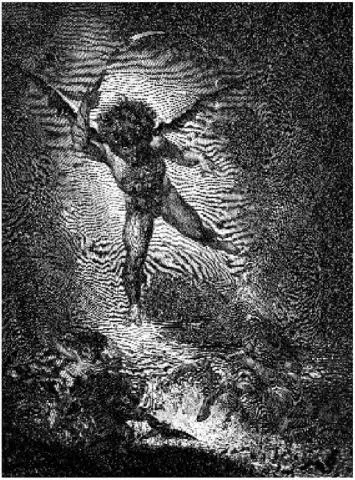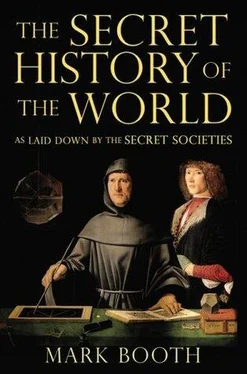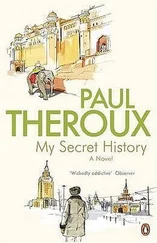
Illustration to A Midsummer Night’s Dream . The word ‘fairy’ entered the English language in the thirteenth century from the old English word to marvel and originally referred to a state of mind — feyrie or fayrie meaning the state of being enchanted. J.R.R. Tolkein defined faerie as ‘beauty that is an enchantment’.
The main story of The Taming of the Shrew comes from The Sleeper and the Watcher , a story in which Haroun al Raschid puts a gullible young man into a deep sleep, dresses him in royal clothes and tells his servants to treat him as if he really is the Caliph when he awakes.
This, then, is a story about altered states of consciousness — and both story and play contain descriptions of how a higher state of consciousness may be achieved.
The outer, framing plot of The Taming of the Shrew centres on Christopher Sly. In Sufi lore a sly man is an initiate, or member, of a secret brotherhood. Christopher Sly is described in the first folio as a beggar, another Sufi code word, a Sufi being ‘a beggar at the door of love’.
Early in the play Sly says: ‘the Slys are no rogues. Look at the Chronicles. We came in with Richard the Conqueror.’ This is a reference to the Sufi influence that Crusaders brought back from the Crusades.
Sly is also shown as a drunkard. As noted earlier, drunkenness is a common Sufi symbol for a visionary state of consciousness.
Then Sly is woken up by a Lord, which is to say that he is instructed by his spiritual master on how to awaken to higher states of consciousness.
The story that follows, the taming of the shrewish Katharina by Petruchio, is on one level an allegory of the Lord’s ‘awakening’ of his pupil. Petruchio employs sly methods to tame Katharina. She represents what in Buddhist terminology is sometimes called ‘monkey mind’, the never quiet, never still, always gibbering part of the mind that distracts us from spiritual realities. Petruchio tries to teach her to abandon all preconceptions, all her old habits of thinking. Katherina must learn to think upside down and inside out:
I’ll attend her here —
And woo her with some spirit when she comes!
Say that she rail, why then I’ll tell her plain
She sings as sweetly as a nightingale.
Say that she frown, I’ll say she looks as clear
As morning roses newly washed with dew.
Say she be mute and will not speak a word,
Then I’ll commend her volubility
And say she uttered piercing eloquence…
As we saw in Chapter 17, Sufis trace the origins of their brotherhood further back than Mohammed. Some trace its chain of transmission back to the prophet Elijah or ‘the Green One’. The mystical, edgy spirit of the Green One pervades both A Thousand and One Nights and The Taming of the Shrew .
THERE IS A STORY ABOUT THE GREEN ONE which conveys something of these qualities.
The witness to this strange series of events was standing by the banks of the River Oxus when he saw someone fall in. He then saw a dervish run down to help the drowning man, only to be dragged in himself. All of a sudden, as if from nowhere, another man dressed in a shimmering, luminous green robe appeared, and he too flung himself into the water.
It was at this point that things began to turn really strange. When the green man resurfaced, he had magically transformed into a log. The other two managed to cling on to this log and float to the river bank. The two of them climbed out safely.
But the witness was more interested in what happened to the log, and he followed it as it floated further downstream.
Eventually it bumped up against the river bank. Watching from behind a bush, the witness was astonished to see it change back into the green-robed man, who crawled out, bedraggled, but then — in an instant — dry again.
Coming out from behind the bush, the man who had been watching all this felt compelled to throw himself on the ground in front of this mysterious figure. ‘You must be the Green One, Master of Saints. Bless me, for I would attain.’ He was afraid to touch the robe, because now he was close enough to see it was made of green fire.
‘You have seen too much,’ replied the Green One. ‘You must understand that I am from another world. Without their knowing it, I protect those who have a service to perform.’
The man raised his eyes from the ground, but the Green One had disappeared, leaving only the sound of rushing wind.
A YOUNGER CONTEMPORARY OF Shakespeare’s, Robert Burton, wrote in The Anatomy of Melancholy ‘that omniscient, only wise fraternity of the Rosie Cross names their head Elias Artifex, their theophrastian master’. Burton then describes him as ‘the renewer of all arts and sciences, reformer of the world and now living ’ (my italics).
We have already seen how in the esoteric tradition Elijah is believed to have reincarnated as John the Baptist. His return was prophesied not only in the last words of the Old Testament but by the initiate-prophet Joachim, who profoundly influenced the Rosicrucians’ understanding of history. Joachim said Elijah would come to prepare the way for the third age. Did the secret societies of the sixteenth and seventeenth centuries believe that he had reincarnated in their own time and that he was protecting and guiding those with a service to perform?
In Chapter 13 we looked at rather disturbing stories of Elijah and Elisha, his successor. The time has come to consider that in the secret history these passages in the Old Testament are not a description of two separate individuals. Rather, Elijah is such a highly evolved being that not only is he able to incarnate, discarnate and reincarnate at will, he is also able to parcel up bits of his spirit — or mantle — and distribute it among several different people.
Just as a flock of birds turn as one, moved by the same thought, so also several people may be moved simultaneously by the same spirit. Lurking in the darkness behind the surface glitter of Elizabethan England, speaking through the minds of Marlowe, Shakespeare, Bacon, Donne and Cervantes we should be able to make out the stern visage of the Green One, spiritual master of Sufis and architect of the modern age.
We shall look at the aim of Elijah’s mission in the last chapter, but for the moment it is as well to recall the role that Arabia played in inspiring not only literature but science. At the court of Haroun al Raschid and later among the Arab peoples, science had made great leaps forward, particularly in mathematics, physics and astronomy. There is a deep mystical connection between the Arab people and the English, because it was the great Arabian spirit of scientific research which lived again in Francis Bacon, the individual most closely associated with Shakespeare in the occult literature. And, as the history of the philosophy of science tell us, it was Bacon who inspired the great scientific revolution that has done so much to form the modern world.
As the inner cosmos was opened up and illumined, so, too, the material cosmos was opened up and illumined. As Shakespeare revealed a world not of character types, which is what had gone before, but a jostling crowd of fully realized individuals, seething with passion and fired by ideas, so Bacon revealed a world bursting with quiddity, a scintillating world of infinitely various, sharply defined objects.
These parallel worlds ballooned and became mirror images of one another. Inner and outer worlds that had previously been darkly and indistinctly intermingled were now clearly separated.
Читать дальше













